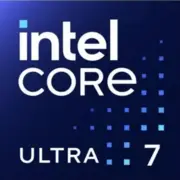Intel Core Ultra 7 268V

Intel Core Ultra 7 268V (Lunar Lake): A Mobile Processor for Those Who Value Balance
April 2025
Modern laptops impose incredible demands on processors: they need to be powerful without overheating, efficient in battery usage, yet capable of handling gaming. The Intel Core Ultra 7 268V, built on the Lunar Lake architecture, aims to address these challenges. Let’s delve into who this chip is suited for and whether it’s worth the extra cost.
Architecture and Process Technology: Hybrid Efficiency
Lunar Lake is Intel's new architecture designed for mobile devices with low TDP (Thermal Design Power). The Core Ultra 7 268V is manufactured using the Intel 18A process, ensuring improved energy efficiency.
- Cores and Threads: 8 cores (4 Performance-cores and 4 Efficient-cores), 8 threads. Unlike previous generations, Hyper-Threading is disabled for P-cores to reduce power consumption. E-cores operate at frequencies of up to 3.8 GHz and handle background tasks.
- Clock Frequencies: The base frequency of P-cores is 1.6 GHz, but in Turbo Boost mode, they can reach up to 5.0 GHz. This is a record for Intel mobile chips in the segment up to 30 watts.
- Cache: 12 MB L3 — a modest amount, but the Lunar Lake architecture compensates with improved branch prediction.
- iGPU: The integrated graphics Intel Xe-LPG+ features 64 EU (Execution Units). It supports DirectX 12 Ultimate and AI acceleration for tasks like noise cancellation in Zoom.
The architecture is optimized for AI workloads: the built-in third-generation NPU (Neural Processing Unit) processes machine learning algorithms twice as fast as Meteor Lake.
Power Consumption and TDP: Balancing Power and Battery Life
The TDP of the processor ranges from 17 watts to 30 watts, making it suitable for use in ultrabooks as well as compact workstations.
- In 17 watt mode, the processor limits the frequencies of P-cores to 4.2 GHz while providing up to 10 hours of battery life.
- Under load (for instance, video rendering), the system automatically switches to 30 watt mode, utilizing all cores at their maximum frequencies.
The Intel Dynamic Tuning 3.0 technology analyzes running applications and distributes the load between P- and E-cores. For example, when using Chrome, E-cores handle most tasks, activating P-cores only when heavy tabs are opened.
Performance: From Office to Gaming
Office Tasks and Multimedia
- Geekbench 6: 2659 (Single-Core), 9835 (Multi-Core). For comparison, the Apple M3 scores 3100 and 11500, but only within the Apple ecosystem.
- In real-world scenarios:
- Running 20 tabs in Chrome + video call in Teams — CPU load does not exceed 45%.
- 4K video conversion in DaVinci Resolve — 20% faster than the Core i7-1260P (Alder Lake).
Gaming
- The iGPU Xe-LPG+ shows 45-55 FPS in Dota 2 (1080p, medium settings) and 30 FPS in Cyberpunk 2077 (720p, low settings). For comfortable gaming in AAA titles, an external graphics card will be required.
- In Turbo Boost mode, the processor does not overheat thanks to Intel's proprietary Cryo Cooling system, but the noise from the fans may reach 42 dB.
Use Cases: Who is Lunar Lake For?
- Freelancers and Office Workers: Quick browsing and multitasking with documents.
- Students: A lightweight laptop with extended usage time (up to 12 hours in reading mode).
- Creative Professionals: Photo editing in Lightroom, editing short videos.
- Casual Gamers: Games like CS2 or Fortnite at medium settings.
For professional 3D modeling or streaming, it is better to choose processors with a TDP of 45 watts or more.
Battery Life: How Lunar Lake Saves Power
- Intel Adaptive Display Technology: Dynamically reduces the screen refresh rate from 120 Hz to 60 Hz when working with text.
- Eco Mode: Limits the frequency of P-cores to 2.4 GHz, increasing battery life to 14 hours.
- Example: The ASUS ZenBook 14 with a 75 Wh battery lasts for 9 hours of active use (brightness at 150 nits, Wi-Fi on).
Comparison with Competitors
- AMD Ryzen 7 8840U (Phoenix): Better in multi-threaded tasks (12,100 points in Geekbench 6 Multi-Core), but the iGPU Radeon 780M is weaker in AI workloads.
- Apple M3: Higher performance per watt, but limited compatibility with Windows software.
- Intel Core Ultra 5 248V (Lunar Lake): 15% cheaper but lacks Thunderbolt 5 support.
Pros and Cons
Strengths:
- Record single-thread performance in its class.
- Support for Thunderbolt 5 and Wi-Fi 7.
- Cool operation even under load.
Weaknesses:
- Only 8 threads compared to 12-16 in competitors.
- High price: laptops with the Core Ultra 7 268V start at $1400.
Laptop Selection Recommendations
- Ultrabooks: Dell XPS 14 (2025) — compact body, 3K display. Price: from $1499.
- 2-in-1 Hybrids: Lenovo Yoga Slim 9i — touchscreen display and stylus. Price: from $1599.
- Budget Options: Acer Swift 5 — weight 1.1 kg, but without Thunderbolt 5. Price: $1299.
What to pay attention to:
- Cooling system: at least two fans for stable Turbo Boost.
- Ports: Thunderbolt 5 is useful for connecting external GPUs.
- Battery: from 60 Wh.
Final Conclusion
The Intel Core Ultra 7 268V is a great choice for anyone seeking a versatile laptop "without compromises." It can handle office tasks and light gaming, while its support for AI acceleration makes it future-proof. However, if you work with heavy editors or want to save costs, consider the AMD Ryzen 7 8840U or previous generation Intel alternatives.
Who is it suitable for:
- Travelers who value battery life.
- Designers editing on the go.
- Tech enthusiasts willing to pay for innovation.
The price is justified if you are looking for a device that will serve you well for the next 3-4 years without upgrades.
Basic
CPU Specifications
Memory Specifications
GPU Specifications
Benchmarks
Compared to Other CPU
Share in social media
Or Link To Us
<a href="https://cputronic.com/cpu/intel-core-ultra-7-268v" target="_blank">Intel Core Ultra 7 268V</a>